The craftsmanship of wooden furniture is full of centuries old tradition, including the development of decorative veneer surfaces. A veneer is in simple terms a very thinly sliced piece of wood, often selected due to its grain or colour. In some cases, the correct identification of veneer work can help you to explore the era, style and value of your furniture.
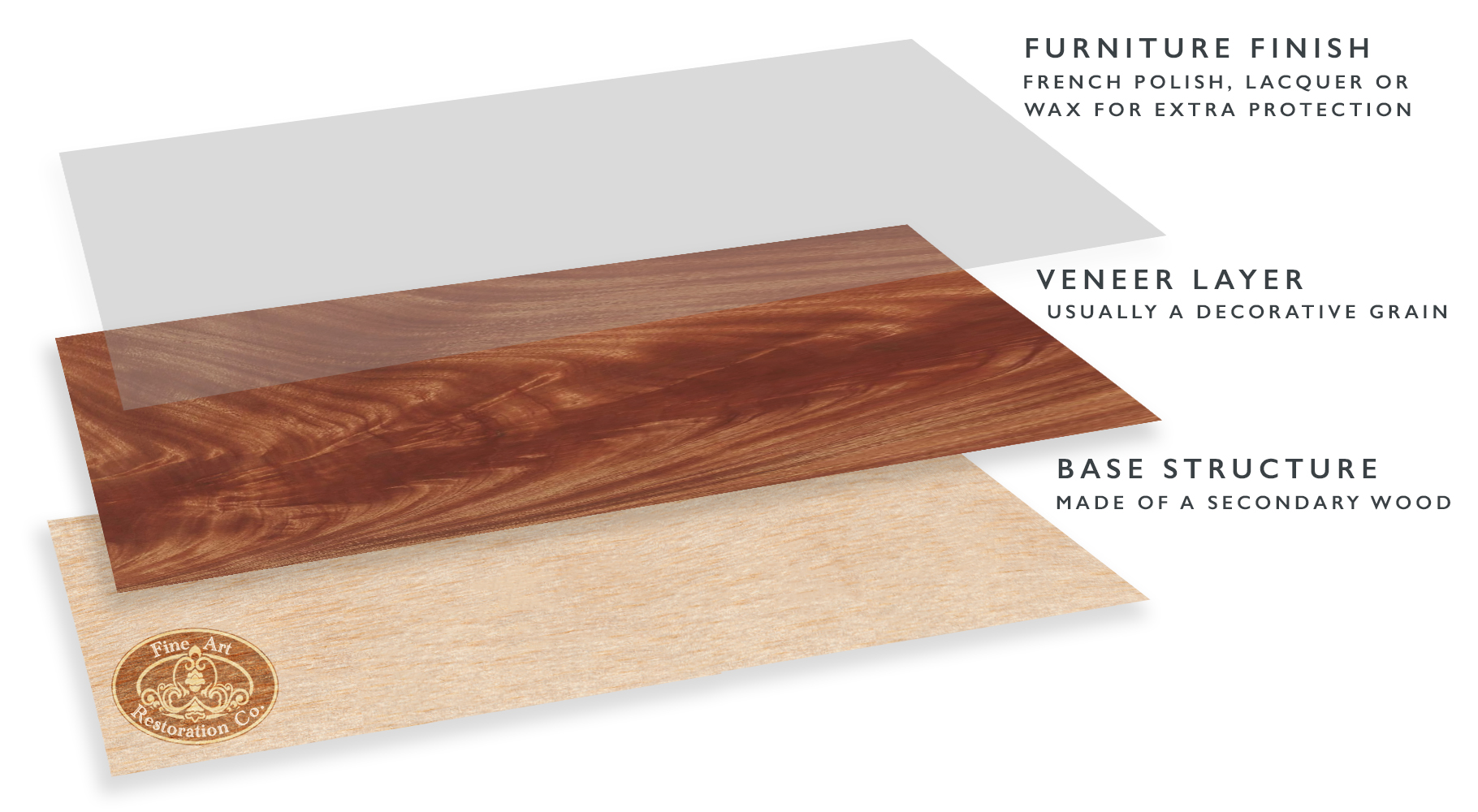
Whilst modern furniture often prizes items formed of solid wood rather than those with veneered surfaces, high quality antique furniture often features beautiful veneer work as a traditional and treasured part of its design. The grain pattern on a sheet of veneer is known as the ‘figure’ or ‘cross figure’ and different types have their own names, such as fiddleback, bird’s eye and raindrop.
 Above: a detail from an early 18th century chest of drawers with maple burl veneer as a key part of the design
Above: a detail from an early 18th century chest of drawers with maple burl veneer as a key part of the design
The most common types of wood used on antique furniture veneer include:
- Walnut
- Mahogany
- Maple
- Ebony
- Yew
- Birch
- Satinwood
- Rosewood
- Kingwood
- Amboyna
- Coromandel
 Above: an early 19th century fall-front secretary with mahogany veneer, a small satinwood veneer desk from 1765 and a late 18th century chest of drawers with mahogany and birch veneers
Above: an early 19th century fall-front secretary with mahogany veneer, a small satinwood veneer desk from 1765 and a late 18th century chest of drawers with mahogany and birch veneers
As well as being chosen for their decorative appearance, some veneers were used by cabinet makers due to the great expense of fashionable timber such as ebony or mahogany. In this case, a thin veneer layer was used on the exterior of a more accessible English wood such as oak and pine. In some cases a sheet of veneer was simply stained to appear as an exotic variety.
You may find veneers used in large sheets to display a beautiful natural pattern, or in smaller pieces to create marquetry patterns. Marquetry inlay is usually created out of different shades of veneer to create a tonal handcrafted pattern or figurative scene.
 Above: detail of a marquetry figure on an 18th century commode surrounded by ormolu (gilt bronze) decoration
Above: detail of a marquetry figure on an 18th century commode surrounded by ormolu (gilt bronze) decoration
Veneers can be applied in various patterns to achieve a desired effect, often the woodgrain from two or more pieces is carefully matched to create a large and naturally beautiful pattern. There are also traditional ways of applying veneers in different panels or in a herringbone shape to use the grain as part of an overall design. Below are some of the traditional applications you may come across.
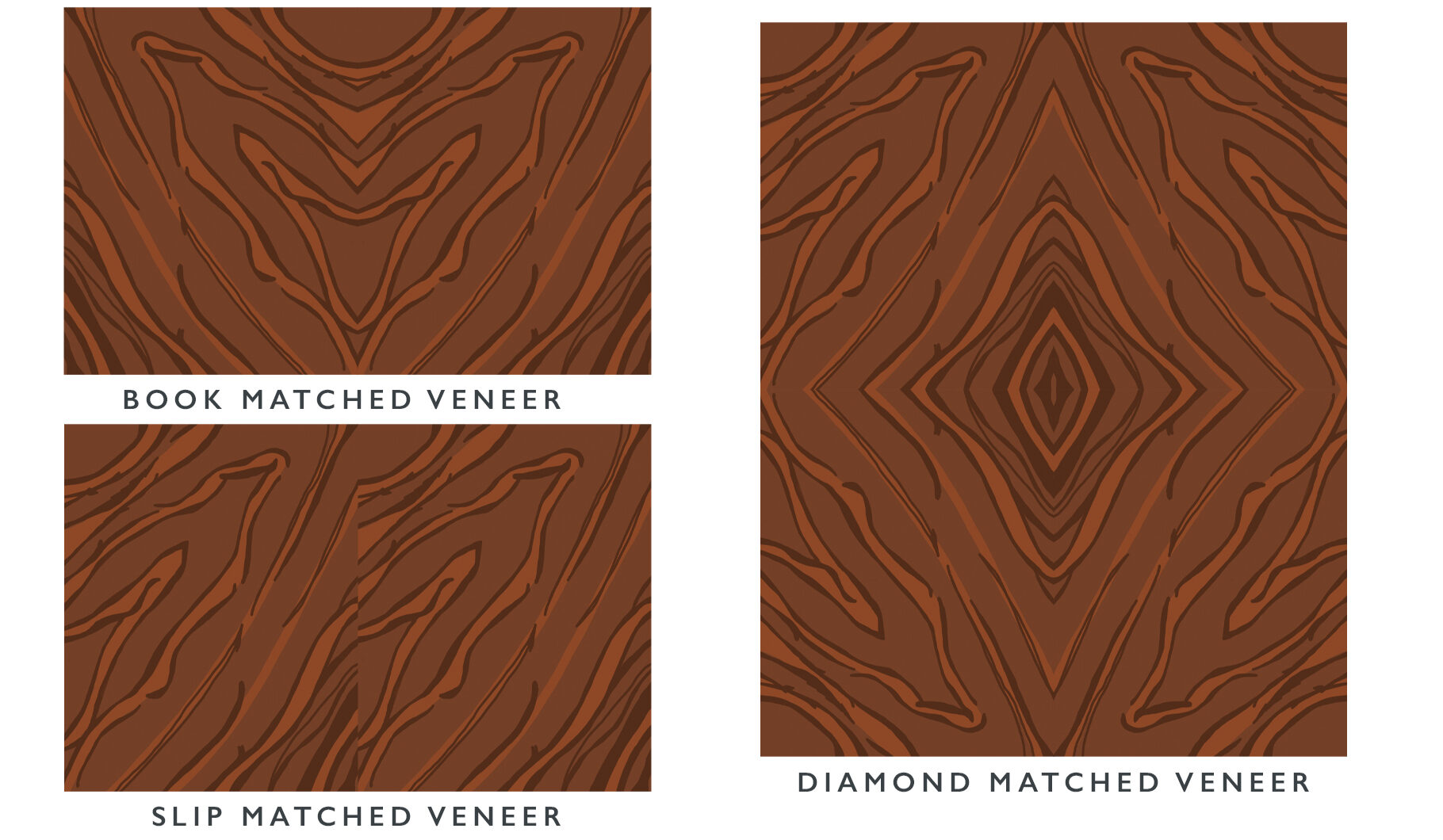
Our furniture specialists have a large collection of historic and modern veneers for the expert revival of damaged areas. They can also save original veneers by using historic techniques and materials to readhere lifting pieces.
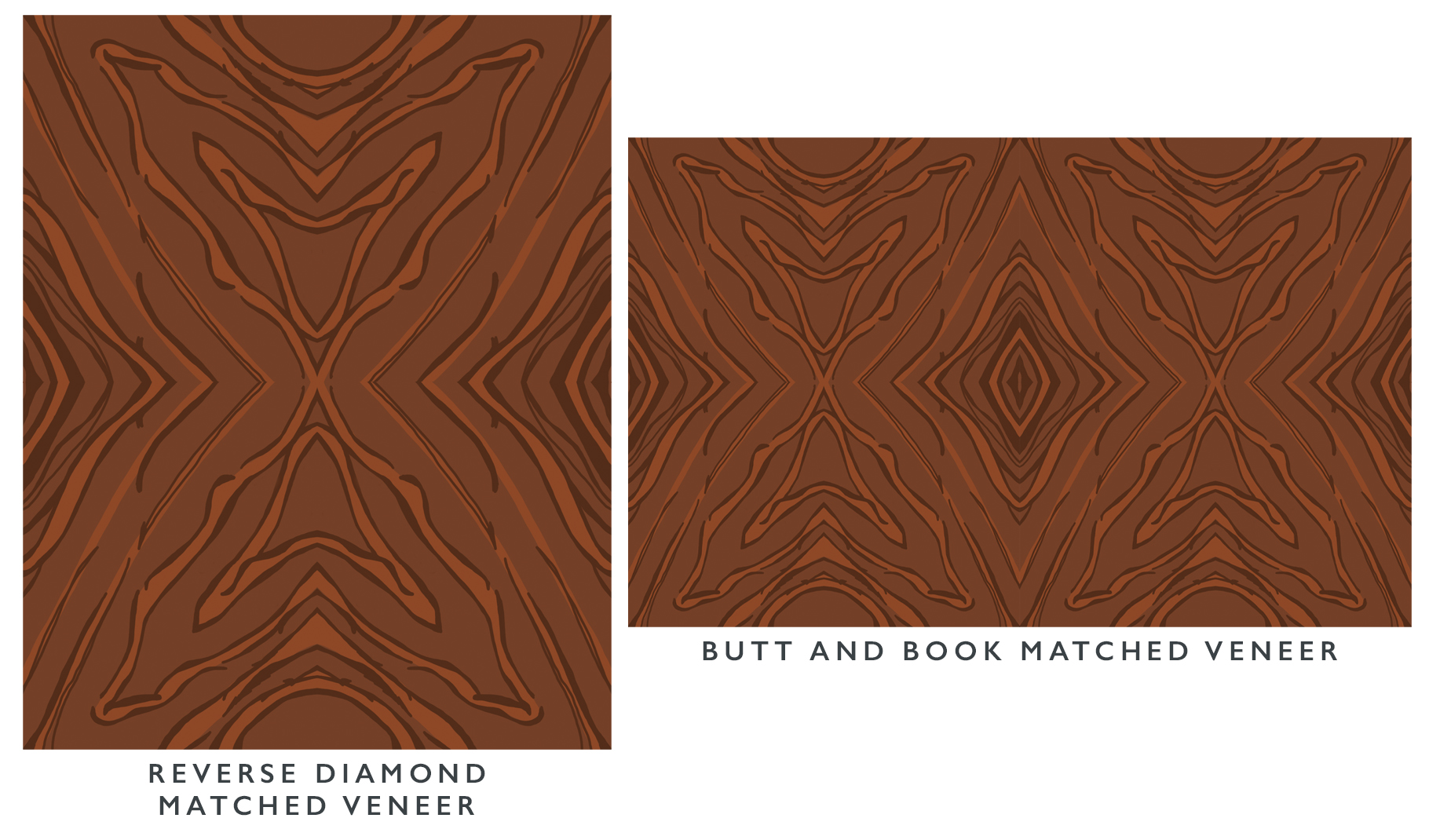
This article will cover some of the veneer types you may come across and the era associated with popular varieties, as well as how our furniture restoration team have been able to continue the tradition of veneer craftsmanship.
 Above: a commode with ebony, boxwood, walnut and fruitwood veneers and a bureau with mahogany veneers, both are mid 18th century
Above: a commode with ebony, boxwood, walnut and fruitwood veneers and a bureau with mahogany veneers, both are mid 18th century
Walnut
Walnut veneers are some of the most popular on antique furniture. Often they appear as a rich brown interspersed with darker knots and curling patterns. The grain of a fashionably elaborate walnut veneer is created by areas where branches or roots are sprouting from the trunk or where a growth occurs – creating what is known as burr walnut or burled walnut.
 Above: examples of walnut burr veneer on a side table from 1735 and an armchair from 1730
Above: examples of walnut burr veneer on a side table from 1735 and an armchair from 1730
Whilst walnut was used in the 17th century in its solid form, by the early 18th century it became a highly desirable veneer. The most sought after patterns caused by burl growths and sprouts were limited and fairly small, so it took a skilled cabinet maker to match them perfectly to create a large item and this skill in itself became part of why well-veneered walnut furniture was so highly prized. A well-crafted piece of 18th century furniture with walnut veneer may fetch a high price at auction.
 Above: the inside of a dressing table with walnut burr veneers, 1720
Above: the inside of a dressing table with walnut burr veneers, 1720
You may find walnut veneer on later pieces too. You will be able to tell if it is later by seeing whether the veneers are too thin to have been crafted by hand and more accurately cut by Victorian industrial methods.
 Above: a 19th century writing desk with burl walnut and rosewood veneers
Above: a 19th century writing desk with burl walnut and rosewood veneers
Whilst walnut can be fairly resistant to water damage if it is quickly and effectively dealt with, its native variety of timber may be more vulnerable to British woodworm infestation. You will be able to tell if woodworm is present through holes and an amount of sawdust gathering around them.
 Above: a detail of walnut burr veneer on an early 18th century side table
Above: a detail of walnut burr veneer on an early 18th century side table
Inactive holes may also be a problem, both to the structure and as an attractive place for pests to return. Our conservators can seal woodworm holes, restore stability and eradicate any active infestation that may be present.
Bird’s Eye Maple
Bird’s eye maple is a specific type of maple veneer that was popular in the regency period and revived again in the early 20th century. Created from the sugar maple, this veneer is specially produced by growing the tree in unnatural and controlled conditions of light and shade. This process forces the wood to constantly begin sprouting new buds to reach sunlight, only to then have them reabsorbed. The product is an attractive speckled pattern that can be highly polished to create an attractive finish for both furniture and panelled interiors.
 Above: detail from furniture with a birds eye maple veneer
Above: detail from furniture with a birds eye maple veneer
Due to the unusual grain on bird’s eye maple, it takes a very skilled cabinet maker to cut, shape and finish it with good effect. Due to the skill required to even cut the maple correctly, it was a very labour intensive material to produce and use. Therefore, this type of veneer is usually found on high quality and high value furniture and specialist items such as violins, the interior panels of cars and private jets, and jewellery boxes.
 Above: a regency era box with burr maple veneers
Above: a regency era box with burr maple veneers
Bird’s eye maple veneers are often a dominant decorative feature. This means that any marks, lifting or stains can create a severe detraction from an item’s aesthetic quality. Our furniture specialists have years of experience in working with antique veneers and can use traditional techniques to secure or repair broken areas as sympathetically as possible.
Mahogany
Mahogany is the most popular tropical variety you may come across on antique furniture. Reddish brown in appearance, mahogany can be used either in solid form or as a veneer. Due to the fine grain of the wood and the size of the trees it is cut from, mahogany prevailed as a timber of choice for cabinet makers for two hundred years, famously favoured by Thomas Chippendale for the vast majority of his designs.
 Above: a selection of antiques with mahogany veneers including a neoclassical card table from 1810-20, a cabinet from 1760 and a Robert Adam style urn on a pedestal from 1780
Above: a selection of antiques with mahogany veneers including a neoclassical card table from 1810-20, a cabinet from 1760 and a Robert Adam style urn on a pedestal from 1780
Mahogany first became available to European markets in the early 18th century, shipped from the Caribbean as a thriving new import, until the 1760s over 90% of mahogany was imported to Britain from Jamaica. As this was a British territory, the majority of mahogany entering Europe came through England and much of it stayed in the hands of British cabinet makers. Supplies began to decline later in the 18th century and today it is illegal to cut and sell most varieties of mahogany due to its threat of extinction. This lack of availability makes antique mahogany pieces even more desirable.
 Above: a detail of mahogany veneer on a Chippendale inspired tea chest, 1760
Above: a detail of mahogany veneer on a Chippendale inspired tea chest, 1760
The mahogany curl veneer is one of the most prized patterns, this is when a piece is cut from an area of the tree dividing into branches. You will find mahogany curl veneers on drawer fronts as well as larger surface areas.
 Above: a tambour door side table with mahogany and maple veneers
Above: a tambour door side table with mahogany and maple veneers
Fiddleback mahogany is named due to its frequent use on musical instruments. The fiddleback pattern is lateral waves that extend across the veneer, these are often perfectly matched in two parallel pieces (as found on the back of a guitar or violin).
 Above: a selection of antiques with mahogany veneers including an early 19th century writing table in the shape of a globe, a mantel clock from the late 18th century and a chaise gondole side chair from 1837
Above: a selection of antiques with mahogany veneers including an early 19th century writing table in the shape of a globe, a mantel clock from the late 18th century and a chaise gondole side chair from 1837
Due to its tropical home, mahogany resists shrinking in humidity and exposure to water very well. However, it is still vulnerable to decay if it is left in damp and untreated conditions and water staining on the surface is something that our furniture team often restore in our studio. Mahogany veneers can be stabilised or replaced if required. Our team has a large supply of antique veneers from salvaged furniture that they use wherever possible to maintain historic integrity.
Industrial furniture veneers
Due to the innovations of the industrial revolution, veneers could be cut precisely by machines and mass produced. Marc Isambard Brunel (father of Isambard Kingdom Brunel) created a hand operated veneer machine in 1806 and in 1843 the first veneer manufacturing facility was opened in Germany. Veneers became thinner, much easier to produce and therefore more accessible to the public. However, this does not mean that industrially veneered furniture is less admired and many 19th century items are still valuable today.
Furniture veneer restoration
In our furniture restoration studio, our experts have a supply of antique and modern veneers to use when original parts are broken, lost or severely damaged. As well as larger areas of veneer, our team can fit precise pieces to curved edges, marquetry and stringing or edging. Our team aims to match the woodgrain of the original appearance to retain the quality of the design, as well as the colour and finish.
Traditional techniques are used, such as the application of bone hide glue to reapply lifting or new veneers. This is the same adhesive that would have been used by historic cabinet makers and our team pride themselves on continuing the methods that have been in use for centuries.
Restoring veneer is not only important for the visual impact of the furniture, but for its overall stability. Weakened areas may lead to further deterioration and unprotected, untreated inner wood may become more vulnerable to its environment.
What do our clients say?
We pride ourselves on updating our clients every step of the way and providing a safe and highly skilled restoration. Following a recent restoration of damaged veneer on an antique credenza cabinet, the owner had this to say:
“I have just received my credenza back and I am just overwhelmed by the way you have repaired it, please, please give your furniture expert my thanks for a wonderful job done. I thought all the craftsmen had gone and it is so reassuring to know they are still here if you look in the right place, thanks once again.”
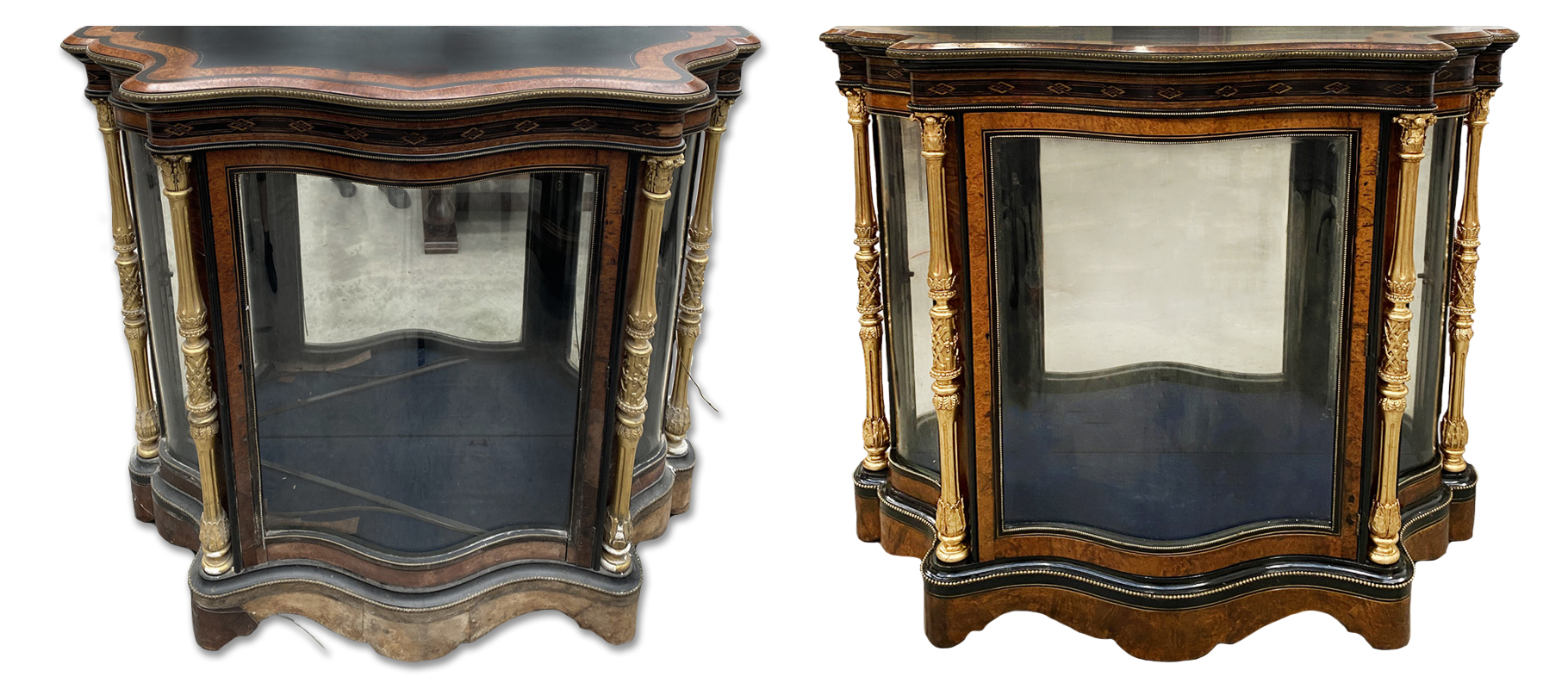
If you have any questions related to veneer deterioration or damage on antique or modern furniture, please contact our helpful team for further advice and an obligation-free quotation.
To make contact please email us via [email protected] or call 0207 112 7576

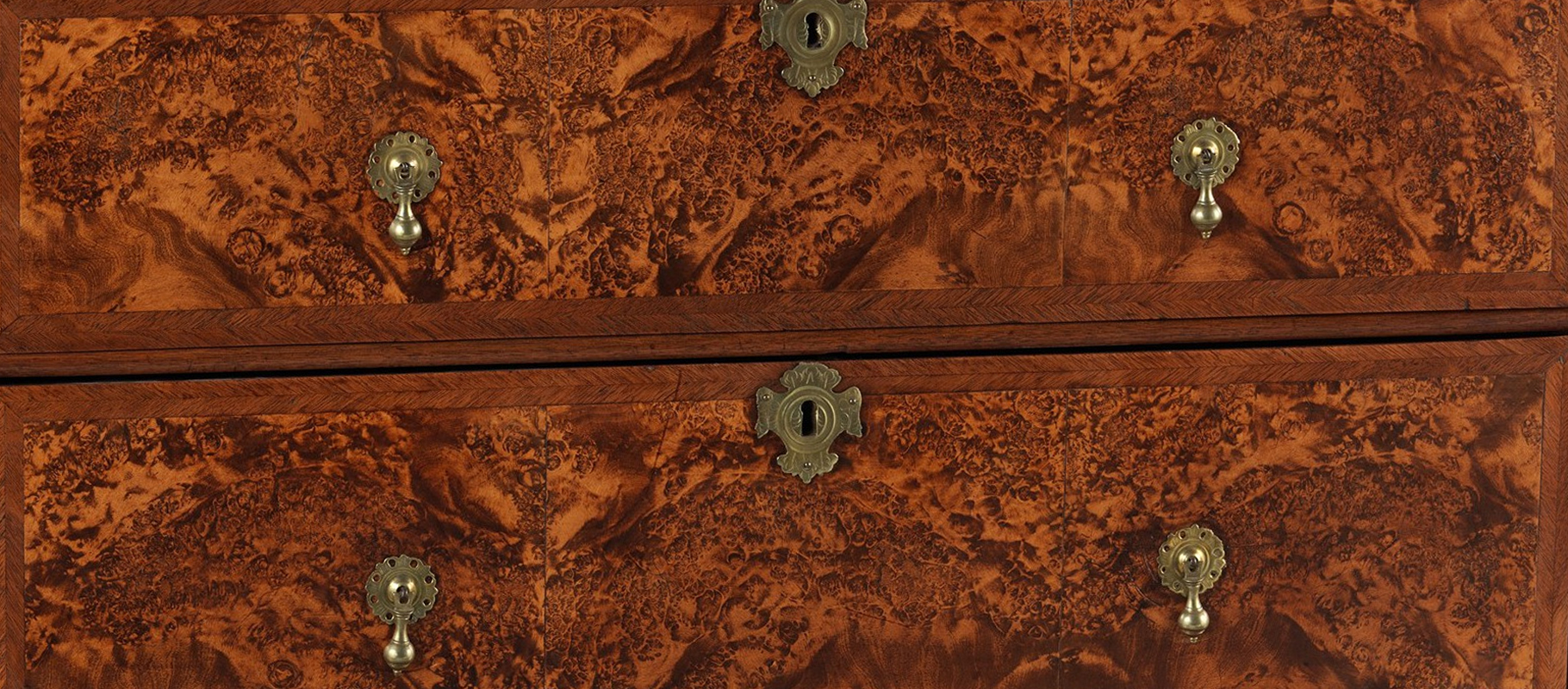 Above: a detail from an early 18th century chest of drawers with maple burl veneer as a key part of the design
Above: a detail from an early 18th century chest of drawers with maple burl veneer as a key part of the design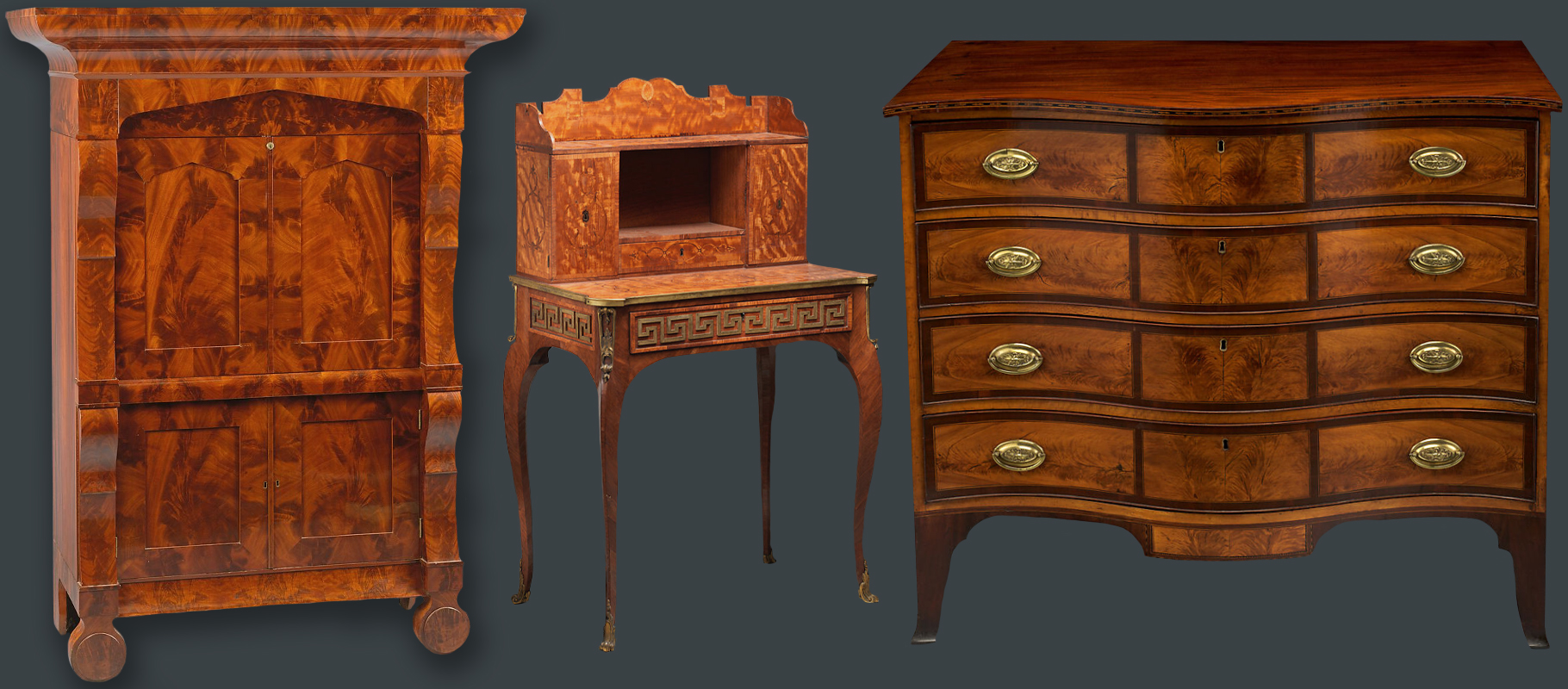 Above: an early 19th century fall-front secretary with mahogany veneer, a small satinwood veneer desk from 1765 and a late 18th century chest of drawers with mahogany and birch veneers
Above: an early 19th century fall-front secretary with mahogany veneer, a small satinwood veneer desk from 1765 and a late 18th century chest of drawers with mahogany and birch veneers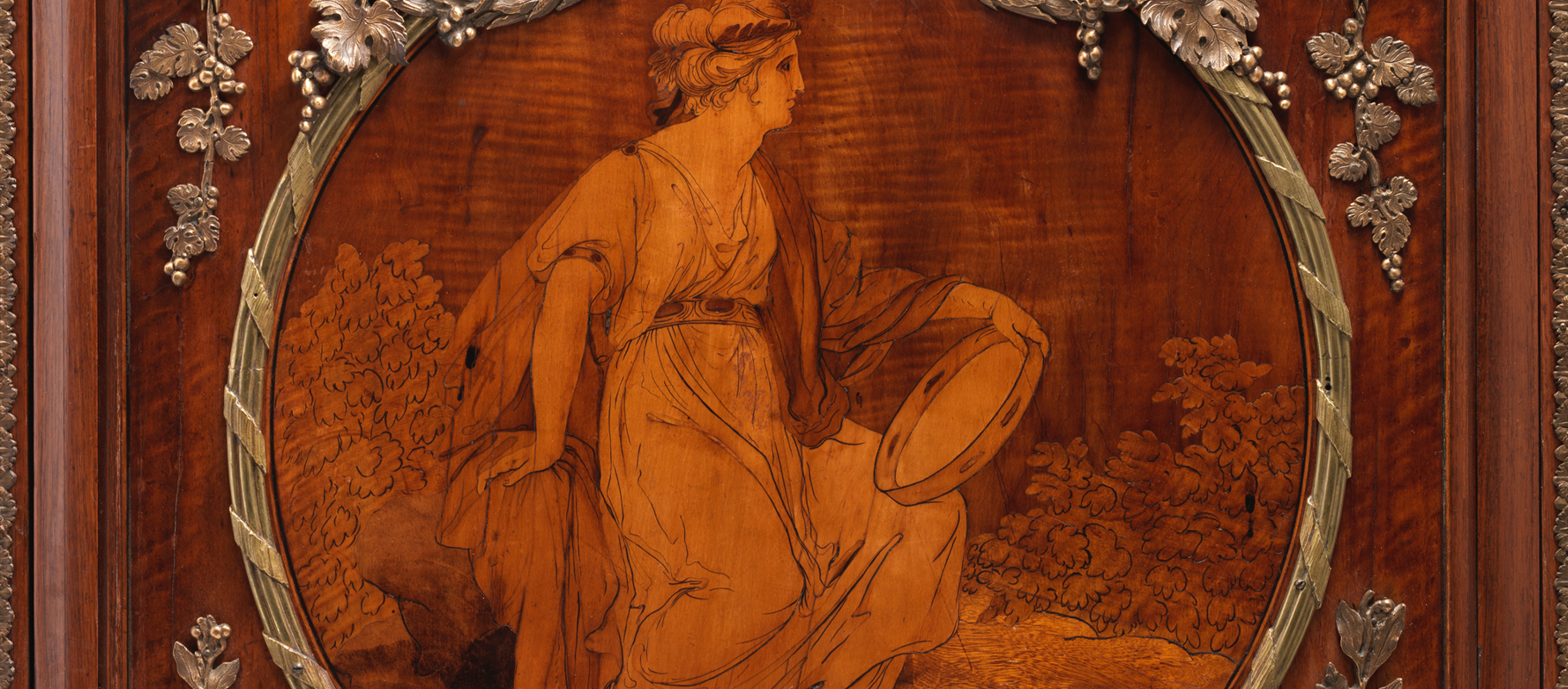 Above: detail of a marquetry figure on an 18th century commode surrounded by ormolu (gilt bronze) decoration
Above: detail of a marquetry figure on an 18th century commode surrounded by ormolu (gilt bronze) decoration Above: a commode with ebony, boxwood, walnut and fruitwood veneers and a bureau with mahogany veneers, both are mid 18th century
Above: a commode with ebony, boxwood, walnut and fruitwood veneers and a bureau with mahogany veneers, both are mid 18th century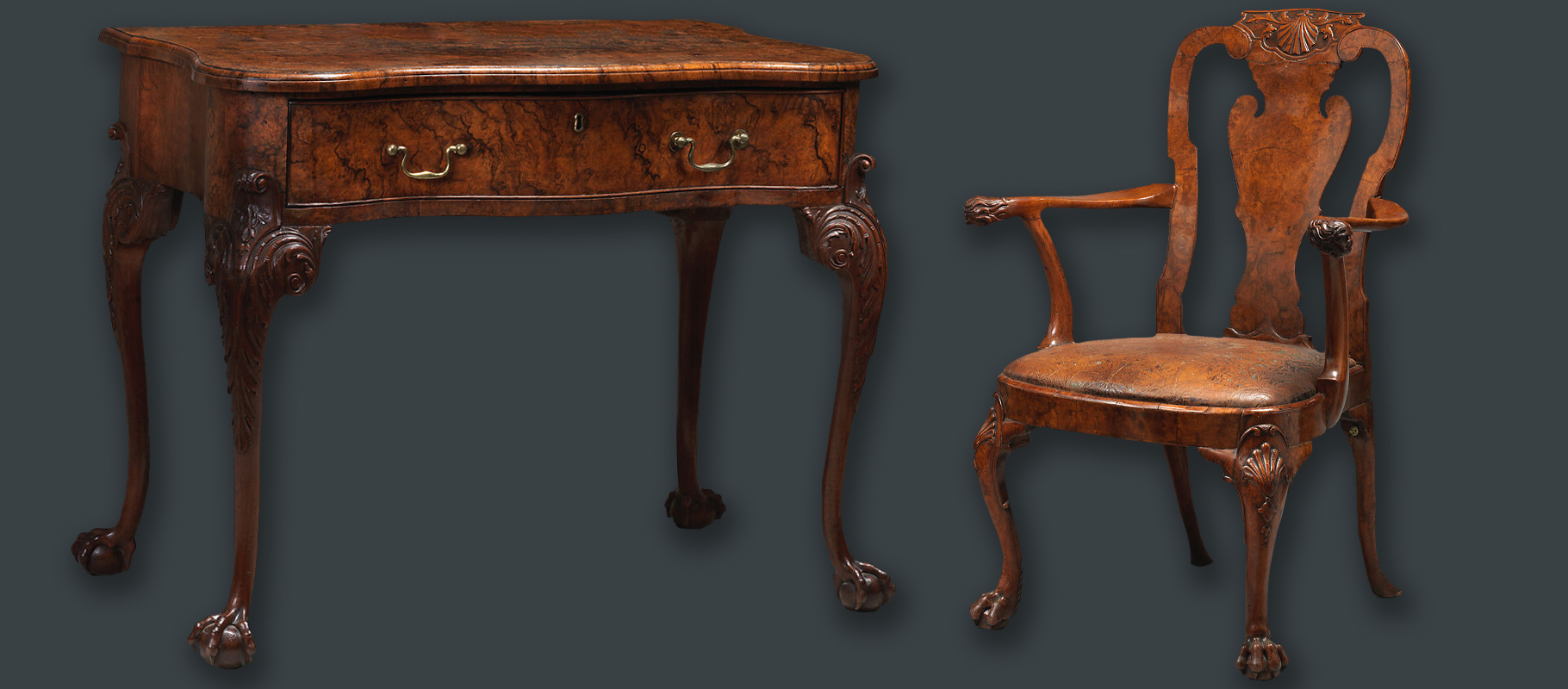 Above: examples of walnut burr veneer on a side table from 1735 and an armchair from 1730
Above: examples of walnut burr veneer on a side table from 1735 and an armchair from 1730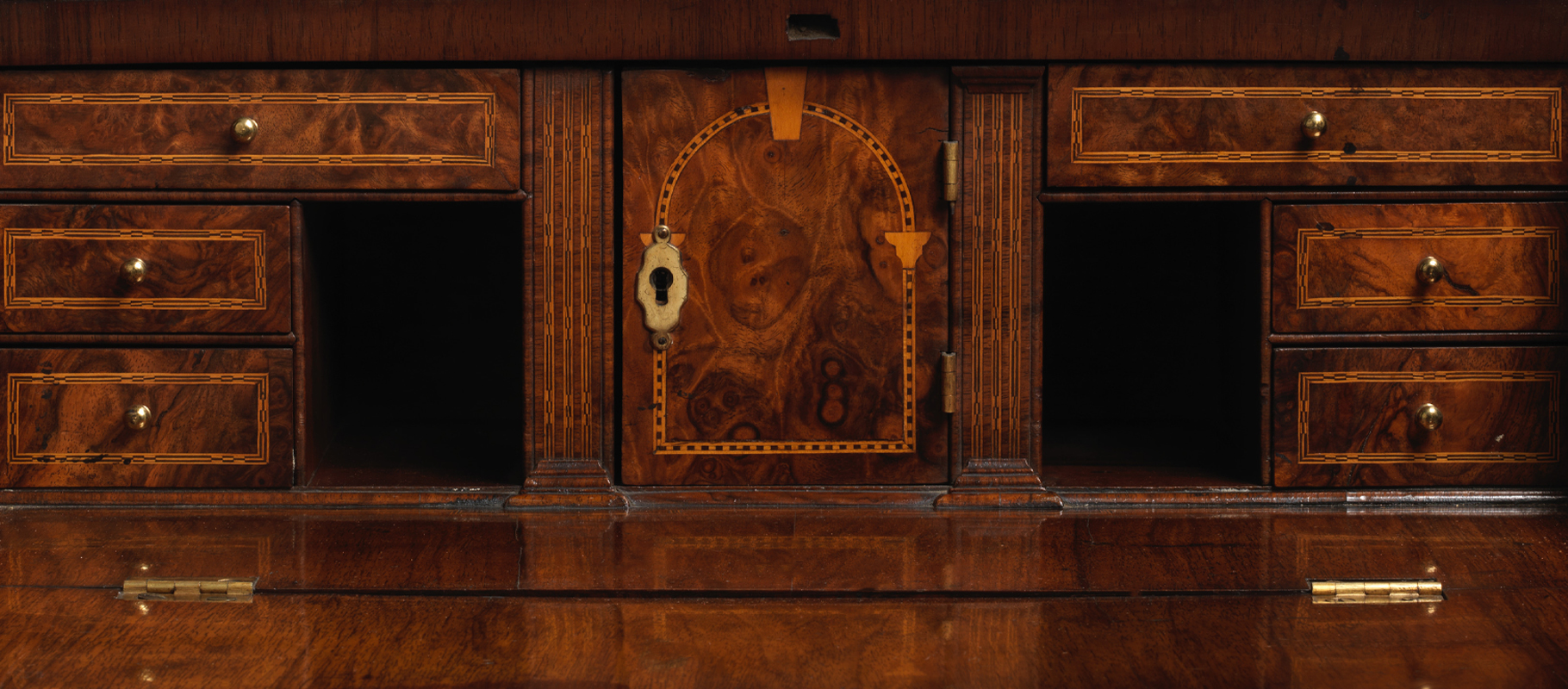 Above: the inside of a dressing table with walnut burr veneers, 1720
Above: the inside of a dressing table with walnut burr veneers, 1720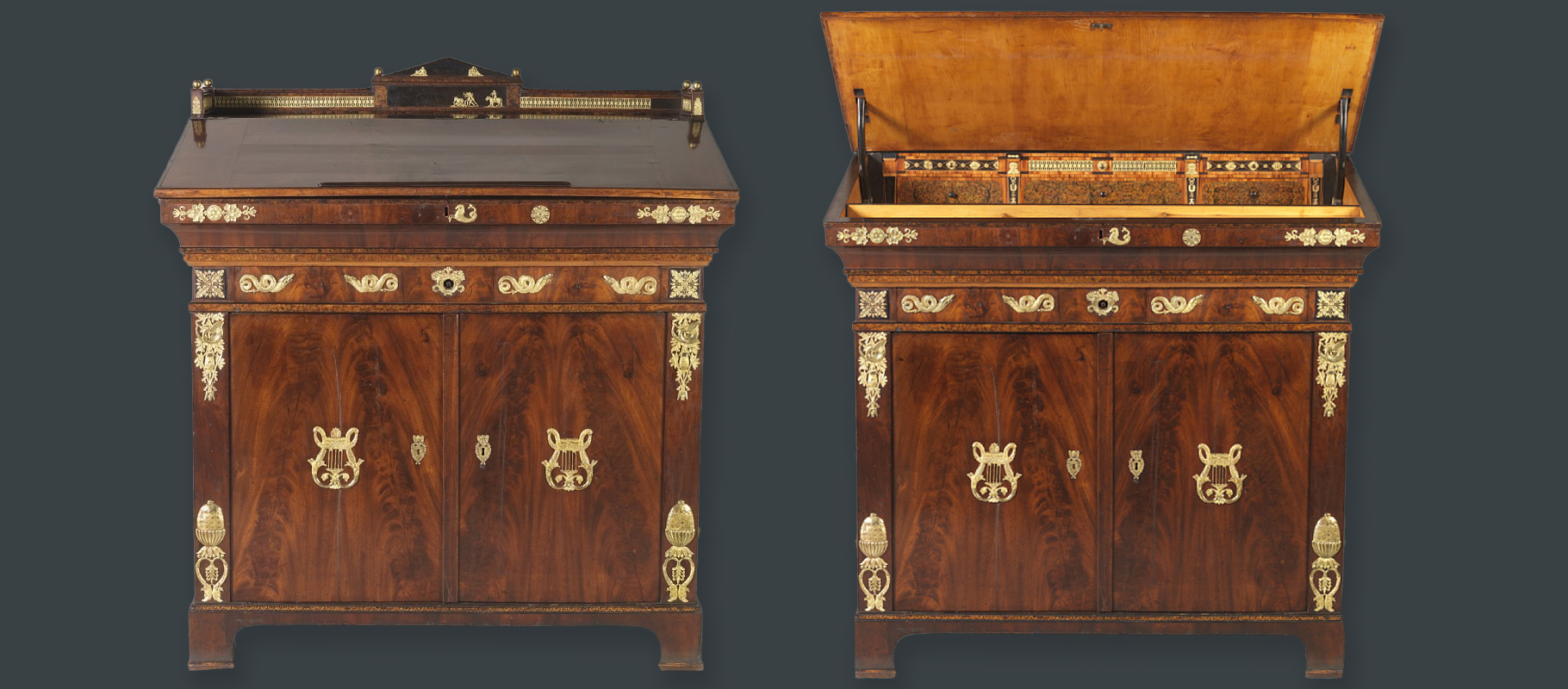 Above: a 19th century writing desk with burl walnut and rosewood veneers
Above: a 19th century writing desk with burl walnut and rosewood veneers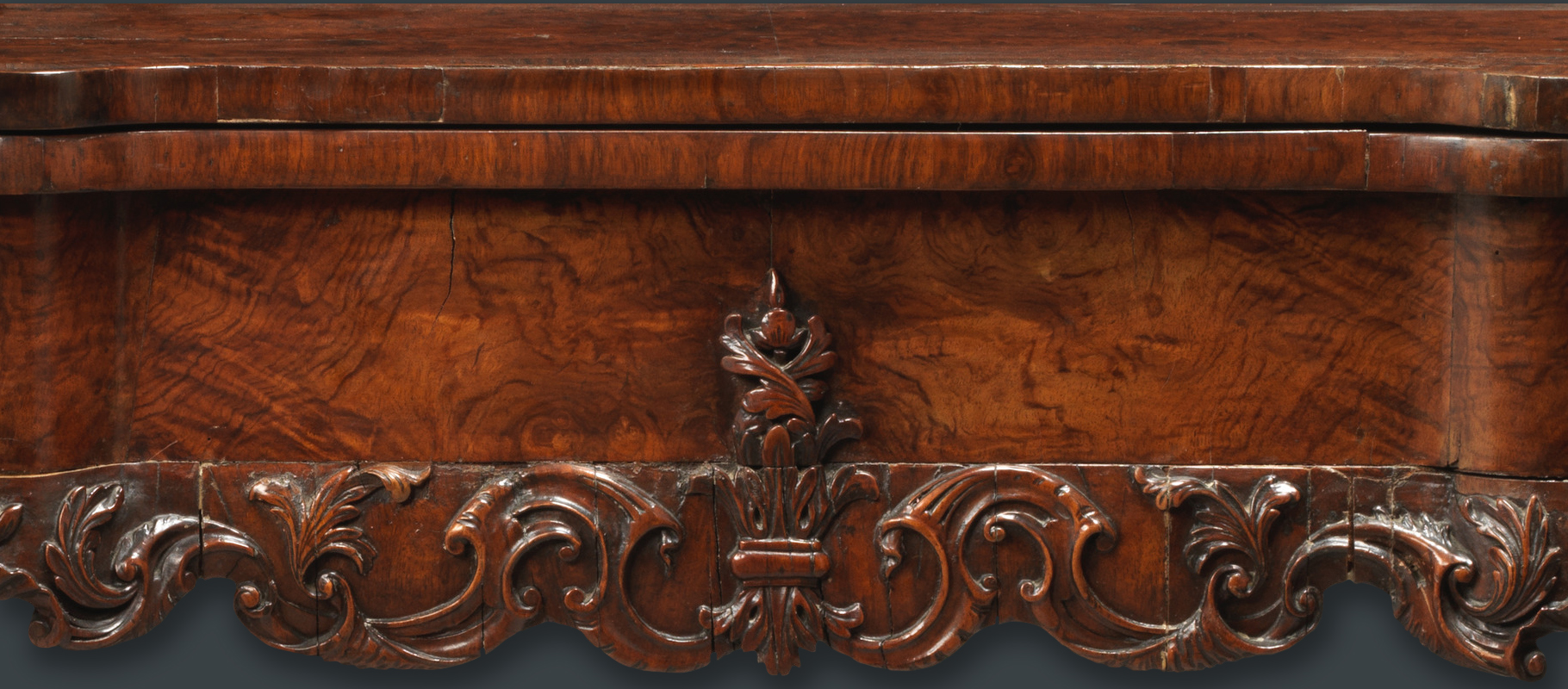 Above: a detail of walnut burr veneer on an early 18th century side table
Above: a detail of walnut burr veneer on an early 18th century side table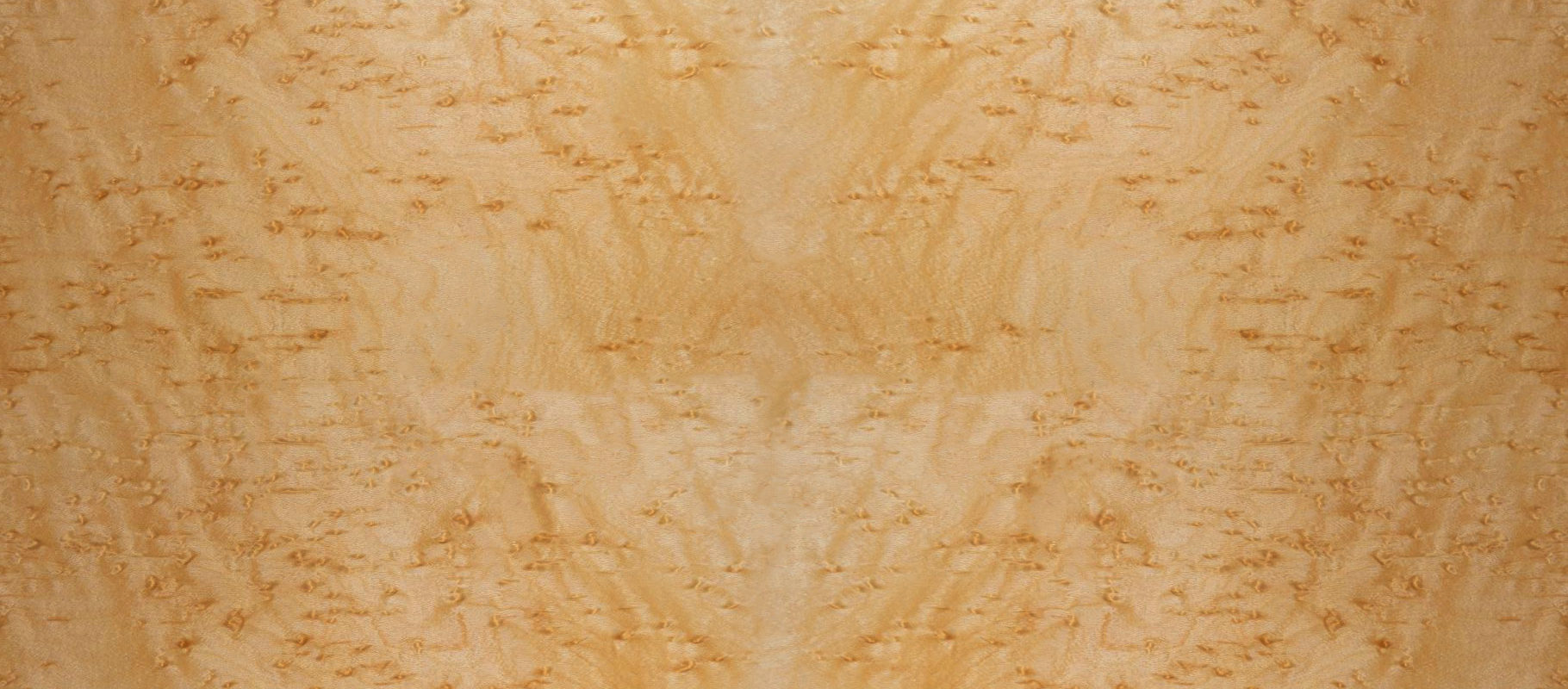 Above: detail from furniture with a birds eye maple veneer
Above: detail from furniture with a birds eye maple veneer Above: a regency era box with burr maple veneers
Above: a regency era box with burr maple veneers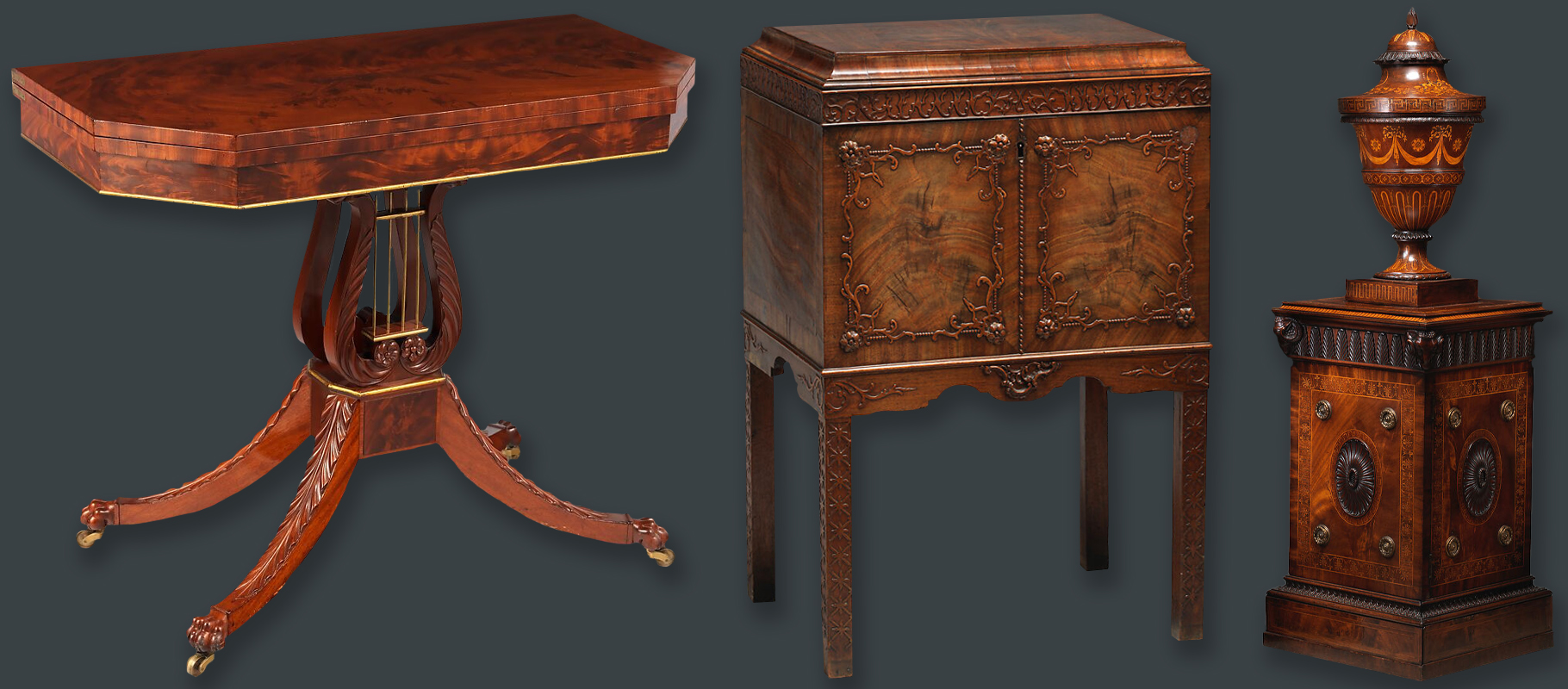 Above: a selection of antiques with mahogany veneers including a neoclassical card table from 1810-20, a cabinet from 1760 and a Robert Adam style urn on a pedestal from 1780
Above: a selection of antiques with mahogany veneers including a neoclassical card table from 1810-20, a cabinet from 1760 and a Robert Adam style urn on a pedestal from 1780 Above: a detail of mahogany veneer on a Chippendale inspired tea chest, 1760
Above: a detail of mahogany veneer on a Chippendale inspired tea chest, 1760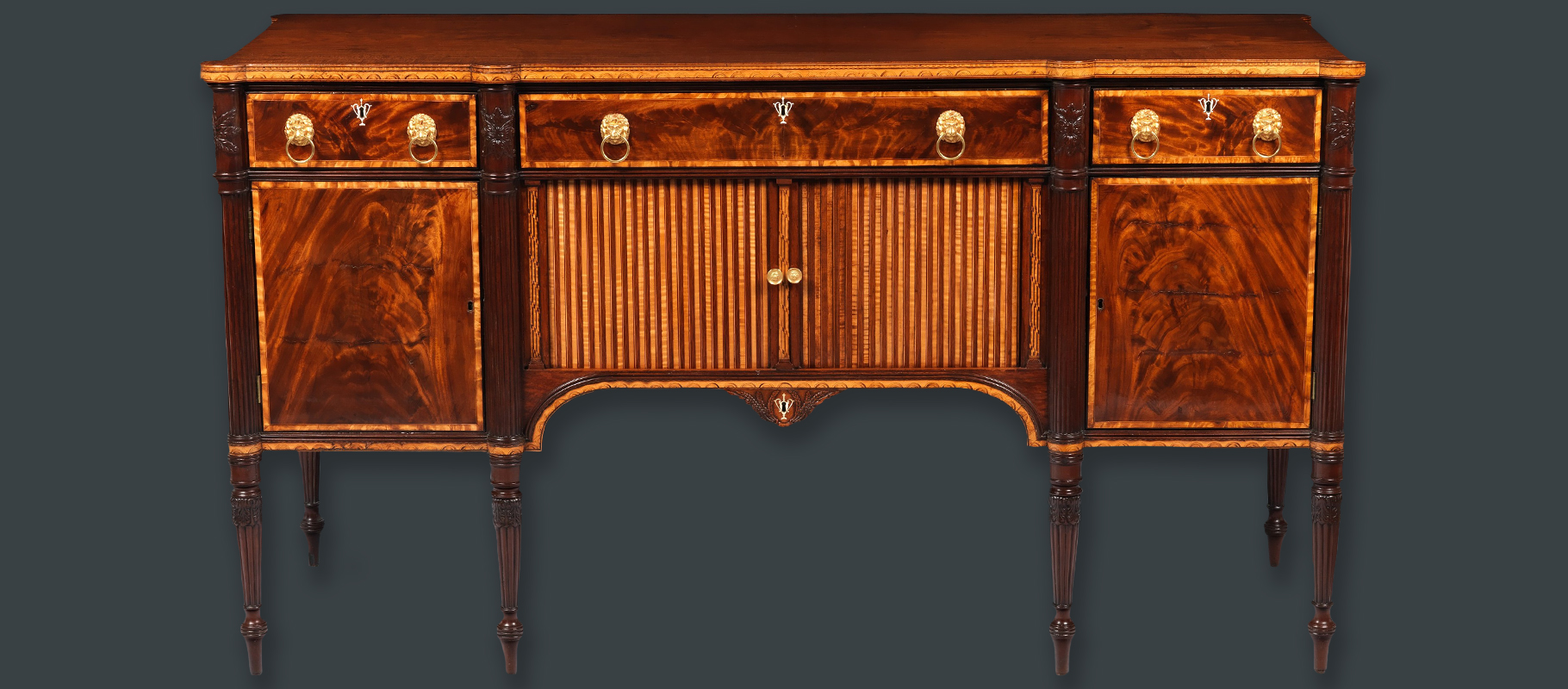 Above: a tambour door side table with mahogany and maple veneers
Above: a tambour door side table with mahogany and maple veneers Above: a selection of antiques with mahogany veneers including an early 19th century writing table in the shape of a globe, a mantel clock from the late 18th century and a chaise gondole side chair from 1837
Above: a selection of antiques with mahogany veneers including an early 19th century writing table in the shape of a globe, a mantel clock from the late 18th century and a chaise gondole side chair from 1837




